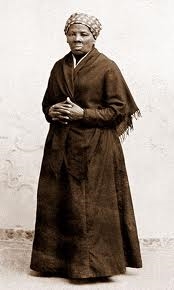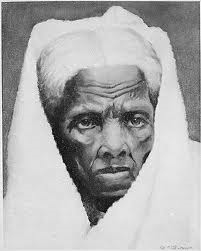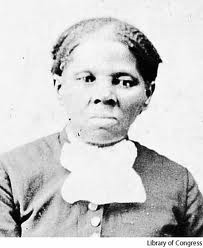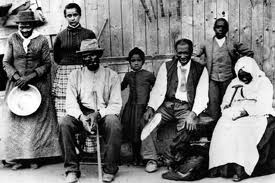 |
"Don't be pushed by your problems, be led by your dreams." This quote from transcendentalist Ralph Waldo Emerson describes the persistent, determined efforts of the American hero Harriet Tubman to undermine the efforts of slave owners. By utilizing her intelligence, leadership, and through selfless acts of bravery, Tubman was able to guide herself and many others to a life of freedom. Harriet Tubman was born Armanita Ross to Harriet and Benjamin Ross in 1820, but later adopted her mother's name. Tubman grew up a slave with her 11 other sisters and brothers in Dorchester County, Maryland. At age 25 in 1844, she married John Tubman, a free African American. However, she was still a slave. Tubman aspired to be free, but her husband disagreed with her plans and threatened to tell the slave master if she tried to escape. Eventually Tubman left her husband and independently escaped from the wrath of slavery in 1849. She arrived in Philadelphia a free woman. Yet, she still felt something was missing. Over the next ten years, Tubman defiantly reentered the South and rescued her mother, father, sister, and brother from slavery. After this, she made herself a promise to help her friends and others reach freedom as well, leading to her active involvement in the abolitionist community. She spoke at several abolitionist meetings and became a key part of the Underground Railroad. In 1851, she settled in St. Catherine's, Canada. Here she worked to earn money for her next missions. Within a year, Tubman decided she was ready to assist in freeing more slaves. From 1852-1857, Tubman made 11 trips South to rescue runaways. For the next 10 years, Tubman continued working for the Underground Railroad; however, this career slowly dwindled down. She had made her last trip through the Underground Railroad by 1860, making her career total 19 trips and 300 rescued slaves. Harriet
Tubman then resettled in Canada for a year. In 1861 she returned to the U.S as a spy for the Union army. She also assisted by organizing an all black regiment for the army and served as a nurse for wounded soldiers. After the war ended, Tubman moved to Auburn, New York where she lived until she died from pneumonia in 1913. With her dedication and determination, Harriet Tubman was able to live a successful and honorable life. Harriet Tubman, the “Moses” of her people, is a hero because of her selfless acts of bravery, her intellect, and her perseverance in the belief that all people are equal.
 |
Through the utilization of her intelligence, Harriet Tubman was able to lead herself and others to a free and jubilant life. Though never formally educated, Tubman took what she knew and made it work. She developed several plans which aided her during the escapes. Often times Tubman would take refugees with her on South-bound trains to trick the slave hunters into thinking they were innocent travelers (Outman). It's remarkable Tubman was able to recognize that African Americans going deeper South weren't suspected as runaway slaves. She lived her whole life imprisoned but was still able to pick up on breaches in the slave hunter's system. Harriet knew exactly what to do to make herself and others arrive safely to the North. Tubman had also thought up many other schemes. A few of these involved the protection of her identity. The majority of the time, Tubman would disguise herself with a variety of costumes. Frequently, she masked herself as an old woman; however, she often changed the specifics of the disguise to keep herself safe (“Harriet Tubman”). Tubman was aware the slave hunters were after her, so she was quick to change her persona. She took a lot of care in protecting herself. The use of several different costumes was clever in making herself and others appear innocent. Without her witty, deliberate plans, Tubman would not have been able to free the 300 slaves she did.
 |
Although typically her intelligent plans didn't fail, Tubman was prepared to act with bravery in order to keep herself and the others unharmed. Harriet didn't let others intimidate her and set out to finish the jobs she began. When Tubman escaped from slavery in 1849, she gallantly reentered the slave states to free her family and other enslaved people. This was a brave act because Harriet had already reached a life of freedom. She could've remained free in Philadelphia, but she put her life on the line again and returned to rescue her family. Nevertheless, Tubman's rescues weren't the extent of her bravery. Harriet Tubman also served as a spy for the Union Army during the Civil War. She helped organize raids, such as the Combahee River Raid. The purpose of this raid was to harass white soldiers and free their captives (“Harriet Tubman”). Thanks to Harriet Tubman, the raid was a success and 500 slaves were freed. Word had spread rapidly about Tubman, and slave hunters were furious she was still free and helping others. A bounty of $40,000 was offered for her capture. Tubman was constantly reminded of her dangerous predicament because of wanted posters and bounty signs. Nonetheless, she continued to fight for the justice and freedom of African Americans and didn't let anything intimidate or stop her from helping her people.
 |
Harriet Tubman can be described as a leader because of her inspirational actions. She motivated others to push for their values and not stop until they were accepted by everyone. Tubman’s main goal was to fight for the freedom of slaves and encourage more people to do the same. In addition to working as an Underground Railroad conductor, a spy, and a nurse, Tubman also served actively in the abolitionist community. She became closely associated with John Brown before his raid on the federal arsenal at Harpers Ferry and admired him enormously all of her life. Other white leaders she personally knew were Thomas Garrett and William H. Seward, as well as Susan B. Anthony, Ralph Waldo Emerson, and the Alcotts. The settlement and growth of the western states led to increased agitation over the institution of slavery, and white progressive leaders supported Tubman's work financially and welcomed her into their homes when she needed shelter. As the controversy over slavery intensified, Tubman became an effective and acknowledged leader in the abolitionist movement, which had a strong and effective organization in Philadelphia (“Harriet Tubman”). This quote shows how well known Tubman was throughout the United States. From starting with nothing, to going to having the support of thousands must have made Harriet Tubman feel empowered and motivated her to keep going. I believe that part of the reason she wasn’t afraid to fail was because she had confidence in herself and the people who supported her. Harriet Tubman also was a leader because of her willingness to support other causes. After her efforts towards slavery paid off, Tubman worked with Susan B. Anthony to help support women’s rights. (“Harriet Tubman”). I believe that Tubman got involved with women’s rights was because at that time women and slaves had many similarities. Both women and slaves were deprived of many rights and not respected enough to have the ability to vote or hold political office. However with years of both Susan B. Anthony and Tubman’s help, women were granted the right to vote. The fact that Tubman was able to help others with their dreams shows that she was not just a leader for the people in her cause, but a leader in all causes.
 |
Harriet Tubman's selfless actions were passed over and forgotten, but have resonated throughout American history. She remains a true hero in the eyes of African Americans and many others. She taught others to battle for what they believe in. Alice Walker, African American poet and author, relates back to Harriet's persistent attempts to succeed in all she did: "We will be ourselves and free, or die in the attempt." She confidently followed her dreams and didn't let anything hold her back. This is what true heroes must do; move past their problems and live the life they imagine for themselves.
Page created on 1/14/2011 12:00:00 AM
Last edited 1/14/2011 12:00:00 AM
Clavin, Matthew. "Tubman, Harriet." World Book Advanced. World Book, 2010. Web. 15 Dec. 2010.
“Harriet Tubman.” Contemporary Black Biography. Vol. 9. Detroit: Gale 1995. Gale Student Resources In Context. Web. 15 Dec. 2010.
"Harriet Tubman." DISCovering Multicultural America: African Americans, Hispanic Americans, Asian Americans, Native Americans. Detroit: Gale 2003. Gale Student Resources In Context. Web. 15 Dec. 2010.
Outman, James L. "Tubman, Harriet." U.S. Immigration and Migration Reference Library. Ed. Lawrence W. Baker, et al. Vol. 4: Vol. 2: Biographies. Detroit: UXL, 2004. 389-395. Gale Student Resources In Context. Web. 15 Dec. 2010.
